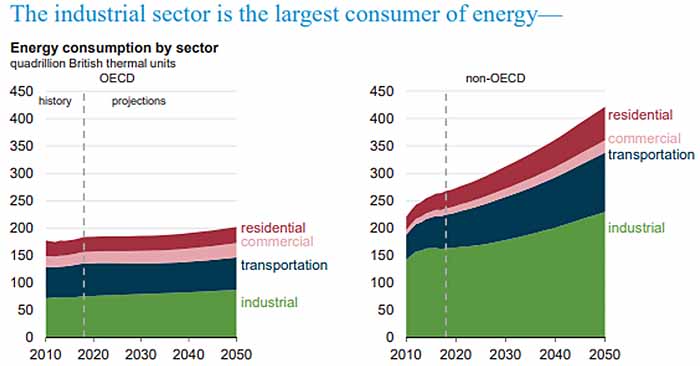Many factors influence the sustainability of a lubricant. These can range from formulation, product manufacturing and packaging, environmental performance, lifespan, product performance, to how the oil is managed at the end of its life.
However, one of the most influential areas resides in its ability to produce a more energy-efficient solution. Increasing the energy efficiency of a lubricant can provide significant energy savings to the machine it’s lubricating, decreasing the organization’s carbon footprint.
Lubricants are used to reduce friction between two surfaces. In essence, a lubricant helps reduce the amount of energy by overcoming frictional forces, which in turn allows work to be done between the two surfaces.
As such, lubricants are known for increasing the energy efficiency of applications by significantly lowering the coefficient of friction. Twenty-five years ago, the lowest coefficient of friction between two sliding surfaces was reported as PTFE (polytetrafluoroethylene) at 0.08; however, the lowest values reported today are in the range of 0.0005 which is a significant improvement as per K. Holmberg and A. Erdemir, 20191.
Lubricants’ ability to reduce energy consumption and the associated carbon footprint has continued to progress. Advanced mathematical modeling has allowed researchers to better integrate machine design with lubricant properties.
While lubricant technology will continue to advance, contributing to more energy-efficient machines, efforts are also being made in other sciences. Some of these include ultra-low friction coatings, improved sealing materials, and the use of nanoparticles.
Together, these can all contribute to increasing the system’s overall energy efficiency and reducing associated CO2 emissions.
The Impact of the Industrial Sector
The industrial sector is the largest energy consumer, projected to continually increase into the year 2050, per the International Energy Outlook 20192.
In this study, the industrial sector refers to refining, mining, manufacturing, agriculture, and construction, accounting for more than 50% of end-use energy consumption for the projected period (2018 to 2050).
It is also projected that the world industrial sector energy use will increase by more than 30% from 2018 to 2050 and reach approximately 315 quadrillion British thermal units (Btu), as shown in Figure 1 below.

Figure 1: Energy consumption by sector. Source: U.S. Energy Information Administration (where OECD represents the Organization of Economic Cooperation and Development)
According to a report by ARPA-E in 20173, over the last decade, annual energy consumption in the U.S. approximated 100 quads (1 quad = 1 x1015 Btu = 1.055 x 1018 J).
Approximately 40% of primary energy is used for actual energy services, while 60% is used to overcome friction and constitutes losses. According to the International Energy Agency 20224, energy accounts for 75% of total GHG emissions globally. Energy efficiency through tribology, therefore, plays a significant role in reducing greenhouse gas emissions.
As per Woydt et al. in 20225, reductions in friction can save 2.3 – 4.5 gigatons of CO2 per year. Additionally, increased longevity through wear protection and condition monitoring can save between 1.7-6.8 gigatons of CO2 per annum.
This accounts for more emission reduction than all of the coal-fired power plants in the world. Moreover, this is another example where deploying advanced tribology lowers the carbon footprint, can reduce operating costs, and prevent unplanned downtime.
Achieving Energy Efficiency Through Lubrication
Industrial lubricant applications have become more severe over the last several years due to several factors, including:
Increased demand for higher performance: As machines and equipment become more complex and advanced, they require lubricants that can withstand higher temperatures, pressures, and speeds. This demand for higher-performance lubricants has led to developing synthetic and other specialized lubricants that can operate under extreme conditions.
More demanding operating environments: Many industries, such as mining, construction, and manufacturing, operate in harsh environments that are challenging for lubricants. Exposure to extreme temperatures, heavy loads, and contaminants can cause lubricants to break down more quickly and require more frequent replacement.
Increased emphasis on equipment reliability: In recent years, a growing focus has been on maximizing equipment reliability and minimizing downtime. This emphasis has led to the development of lubricants that can extend the life of machinery and reduce the need for repairs or replacement.
Stricter environmental regulations: With increasing concern about the environmental impact of industrial activities, many industries are subject to more stringent regulations on using and disposal of lubricants. This has led to the development of more environmentally friendly lubricants that are biodegradable and less harmful to the environment.
While managing these additional operational stresses, lubricants are also formulated to be more energy efficient with a lower carbon footprint. These factors have contributed to the developing of more advanced base stocks and additive systems.
As per ARPA-E in 2017, lubricants need to be stable at higher temperatures, protect against the formation of deposits, inhibit corrosion, have improved water and air separation, and have no tendency to cause foam.
Several industrial applications can appreciate significant energy reductions using more energy-efficient lubricants.
Bearings
Bearings are used in many industrial applications to support rotating machinery. They can experience high loads and speeds, resulting in significant friction and wear.
Engineers can reduce friction and wear using high-quality lubricants, such as synthetic oils or greases, resulting in less energy consumption and longer bearing life. In this application, the focus on dynamic viscosity is an essential factor in designing a more efficient lubricant.
Gears
Gears are used to transmit power between shafts. They can also experience high loads and speeds, resulting in significant friction and wear. This is especially true in worm gearboxes.
By using high-quality gear lubricants, engineers can reduce friction and wear, resulting in less energy consumption and longer gear life. In gear applications, synthetic base stocks have been shown to provide significant energy improvements.
Compressors
Compressors are used to compress gases. They can experience high temperatures and pressures, resulting in significant friction and wear. By using high-quality compressor lubricants, engineers can reduce friction and wear, resulting in less energy consumption and longer compressor life.
Hydraulics
Hydraulic systems are used to transmit power using fluids. They can experience significant friction and wear, resulting in energy losses and reduced efficiency. Many studies have demonstrated the impact of using high-viscosity index hydraulic oils to reduce energy consumption in hydraulic applications.
The Bottom Line
Woydt et al., in 2022, also attempted to calculate the financial savings that can be provided through friction reduction. It is estimated that for 2019, 26.37 BTU quads of energy were used in these industries; Coal, Renewables, Electricity, Petrol, and Natural Gas. This amounted to >500 million MT CO2eq, which translates to a social cost of carbon loss of $28 billion (calculated at an estimated U.S. 2021 value of $51 per MT CO2eq).
The paper further estimates that advanced tribology can provide a 7.5% reduction in friction. This translates to > $2 billion in equivalent savings by reducing carbon footprint. Add energy savings to these and operational improvements in lubricant performance, it is clear that tribology has tremendous potential to improve profitability while reducing carbon emissions simultaneously.
References
- “The impact of tribology on energy use and CO2 emission globally and in combustion engine and electric cars,” Kenneth Holmberg, Ali Erdemir, 2019, Tribology International, Volume 135, Pages 389-396, ISSN 0301-679X, https://doi.org/10.1016/j.triboint.2019.03.024.
- “International Energy Outlook 2019 with projections to 2050”. U.S. Energy Information Administration, Office of Energy Analysis, U.S. Department of Energy
- “Tribology Opportunities for Enhancing America’s Energy Efficiency,” A Report to the Advanced Research Projects Agency – Energy at the U.S. Department of Energy, February 14, 2017
- “Energy and Carbon Tracker, 2022 edition”, International Energy Agency
- “Climate and Monetary Benefits of Tribology” – Woydt, M., Shah R., Thomas G. (November 2022)










